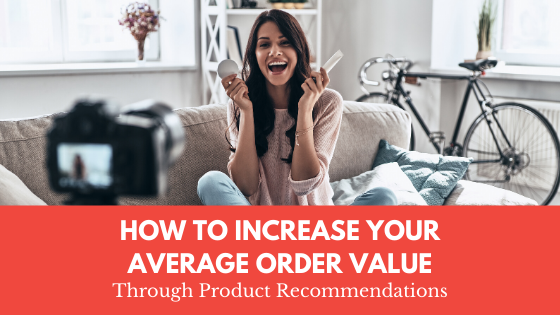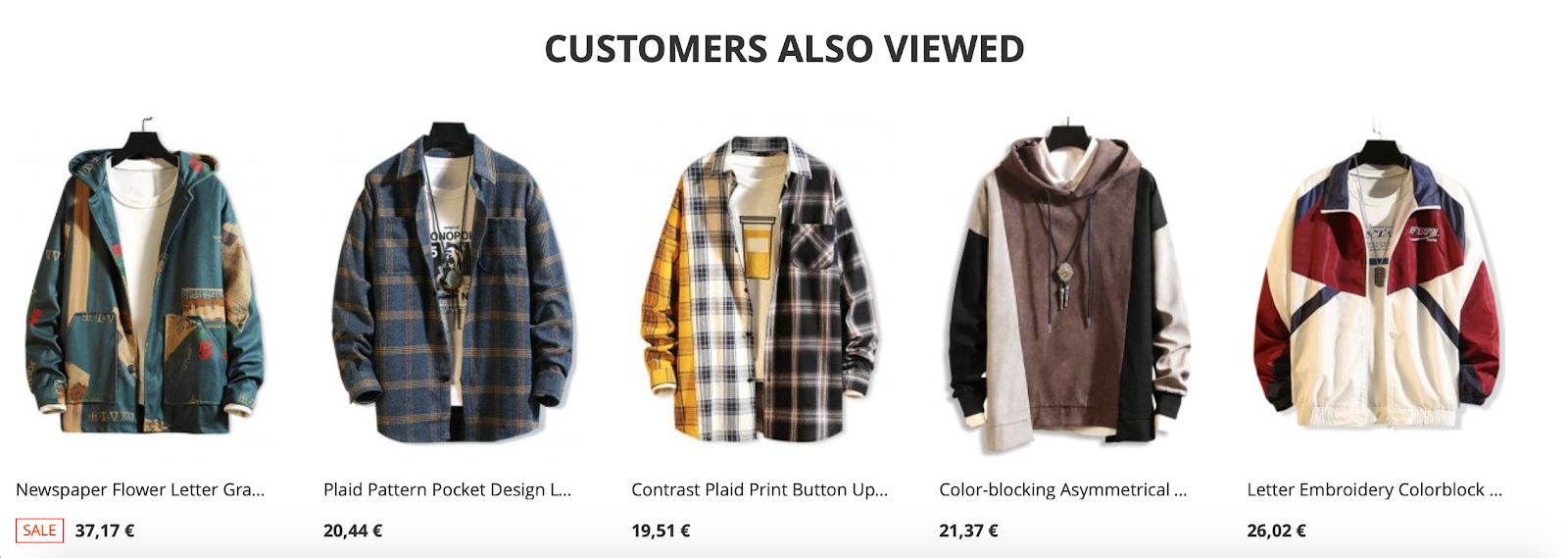Product recommendations are one of the most powerful selling techniques around. Think about a time you’ve visited a brick and mortar store. We all think we’re immune to salesmen. In reality, it’s hard not to be swayed by someone who knows more than you do.
Of course, in the world of online shopping, it’s harder to take advantage of this effect. However, there are still steps you can take to steer your customers towards the perfect product for them.
These days, product recommendations are still an effective way to boost order values on e-commerce stores. In this article, we’ll look at several ways that this can be achieved, as well as some concrete examples of product recommendations in action.
First, some background...
Why you Should Use Product Recommendations
The core of any good product recommendation strategy is figuring out which products are right for your customers. However, unlike in the past, this isn’t done with personal intuition or expertise.
Instead, the e-commerce sphere uses data on its customers to decide on the best product recommendations. This can be done with a native function in your e-commerce platform or using a third-party plugin.
This is great since you don’t need to be a data science expert to get the benefits of product recommendations. All the same, it’s important to understand a little bit of the theory behind these tools.
In practice, there are three main ways that these tools come up with product recommendations:
The Content Focused method - This uses cookies to track your customer’s behavior, to determine their likes and interests
The Collaborative method - This uses buying patterns from other customers to find trends as a basis for product recommendations
The Hybrid Method - This uses elements of the first two methods in tandem
Now you understand what makes product recommendation tools tick. Next, we’ll look at how to leverage these to increase your average order value.
There are two ways that these techniques will increase order values:
By steering customers towards a more expensive alternative product
Or by encouraging customers to buy additional products as accessories or add-ons
Now, here’s ten ways that this works in practice.
Suggested Products
The most common product recommendation you’ll find uses the ‘recommended for you’ format. This is a hybrid approach. To some extent, it can take into account the customer’s browsing history. Mostly though, it just recommends similar items.
The goal is to increase order values by directing customers to a pricier alternative.
As much as this is a popular way to recommend products, it’s also not the most effective approach. There’s generally very little real personalization, so these recommendations tend to have poor conversion rates.
The example above is from ASOS, but the only thing all of the products on display share is that they’re ostentatious shoes.
While a product recommendation like this is better than nothing, you have several much better options. A ‘recommended for you’ style recommendation is the bare minimum that you should implement.
Email Recommendations
Of course, product recommendations can also appear off your site. This is most often done through email marketing. The benefits of this are numerous. For one thing, it can help you to salvage lost sales through cart abandonment emails.
However, using email marketing to increase order values works a little differently. That is after you’ve optimized and sent your email with a great sales email subject line, you have a shorter window of opportunity to upsell extra products or upgrades. For physical products, this is before the initial order is dispatched.
If you sell services, this is a little easier.
In either case, the trick is to use your standard automated emails to recommend products. The great thing about this is that users are more likely to open something like an order confirmation than they are a pure marketing email.
Here’s a typical RyanAir booking confirmation, for example.
Frequently Bought Together
This is probably the most common way to increase order values by adding additional products to the cart. This is generally used when someone is viewing a high-value item. You then push additional low-value items as accessories or necessary add-ons like batteries.
These are pretty effective, but since they’re computer-generated, you can end up with some weird combinations. In the above example, it’s hard to say why anyone would need three pairs of headphones and a Bluetooth speaker.
This example would probably be more effective if they recommended lower value items, like a charging cable or carry case for the first set of wireless headphones.
Customer’s Browsing History
To utilize these product recommendations, you need to collect a certain amount of customer data and then track their behavior. As well as increasing order values, this is a handy way to eke out higher lifetime values from your customers.
The way this works is that a customer isn’t always ready to buy the first time they view a product. However, they might then forget about that product entirely. This type of recommendation is simply a gentle reminder.
Nobody tracks their customers like Amazon. On their homepage, they have a widget to display the last ten or so items you viewed, like so.
This can remind you of an item you previously considered. Equally, it can leave you scratching your head about why you were looking at banana slicers.
Related Item Recommendations
This is another technique aimed at increasing order values by adding on additional products. However, it works slightly differently from ‘frequently bought together’ recommendations. That is, they go together, but they aren’t necessarily bought together often.
Generally, this is because they’re items with a similarly high value, rather than one high-value item and one or more lower value accessories.
Equally, it could be a combination of many high and low-value items.
This is very effective in niches, like home improvement, where customers can be pushed from buying a single product to taking on an entire project. For instance, the example above would more than double the initial order value.
Bundles
Similarly, you have product bundles. With a product bundle, you offer a discount when all the items are purchased together. This type of product recommendation works best when the customer is going to need the extra items at some point anyway.
The goal then is to get them to buy them from you straight away, rather than someone else down the line. The discounted price incentivizes this.
Product bundles are also great, as you can offer flexibility. Budgets differ, so not every customer can afford everything they need all at once. Offering different tiers of product bundle helps to overcome this challenge by offering something in every price range. This is the kind of thing you see a lot of and is effective if you are pushing an offer to your e-store for affiliate marketing purposes.
Updated Products
Humans are simple creatures. One way to show this is how much we love shiny and new things. It’s easy to take advantage of this fact when selling goods. This works well with prestige goods.
This is precisely why car companies release a new model every year. Even if the changes are minuscule, a certain number of people will still splash out on the new model, because it’s the new model.
Similarly, this works well with high-value consumer goods, like computers, cameras, and phones.
Luckily, newer models also tend to have a higher list price.
What’s great about these recommendations is that they require very little effort on your part. Check out the example above. There’s no compelling copy or fancy calls to action. The fact that it’s a newer model is enough.
What Others Bought
One of the most sophisticated ways to use product recommendations is to display what products other people ended up buying. From a marketing perspective, this is gold, since it taps into the herd mentality.
The European music retailer Thomann uses this in a creative and impressive way.
There’s a bunch of things to take in here. Look at the pricing, for instance. Only one of the recommended alternatives is below the price of the item the customer is viewing. This has two effects. It provides a sense of choice while also directing the customer to more expensive alternatives.
Also, the percentage of customers who went for each option is displayed, providing a strong element of social proof to encourage conversions.
Finally, the most popular item is displayed first in the list, underscored with its availability in green text. This is a powerful way to encourage customers to commit to a purchase.
As a bonus, displaying alternative products like this is a great way to rank for long-tail keywords. This is an easy way to use your page structure to boost on-page SEO.
Best Sellers
Another easy to implement technique is directing customers towards the bestselling items in a certain niche. This works in two main ways. Firstly, it focuses your selling efforts on the most popular options. These are naturally the easiest to gain conversions.
‘Bestsellers’ recommendations also have a layer of social proof.
This works better in some industries than others. In particular, these product recommendations are effective in niches with a strong emphasis on trends. The obvious example is fashion.
The example above makes good use of star ratings, which you can add as a structured data markup to your search results. This helps to project quality and legitimacy.
Customers Also Viewed
This kind of recommendation is pretty simple, but if you’re only going to implement one of these techniques, it’s a pretty good all-rounder. The crux of this is that it displays both alternatives and add-ons to increase order values.
This example appears on a listing for a shirt.
As you can see, the recommendation points the customer towards other shirts, as well as hoodies and jackets.
You’ll also notice that most of these are pretty much in the same price range. This is a safe bet for this kind of product recommendation, as customers probably already have a certain budget in mind.
Recommending a Rolex wouldn’t be nearly as effective.
How to Increase Average Order Values with Product Recommendations
One thing is for sure. You’ve got a lot of different options when it comes to product recommendations. However, your best bet is to use a number of these techniques all on the same page.
There’s a reason that big ecommerce platforms like eBay and Amazon usually have dozens of different recommendations on every single listing. Each one builds on the last to boost order values and conversion rates.
ABOUT: OWEN BAKER
Owen Baker is a content marketer for Voila Norbert, an online email verification tool. He’s spent over a decade in online marketing. He enjoys sharing his knowledge of content marketing across a range of websites.





















